|
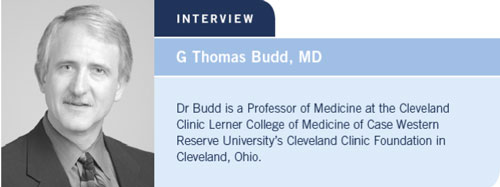
| Tracks 1-13 |
| Track 1 |
Introduction by Neil Love, MD |
| Track 2 |
Capecitabine in the treatment
of metastatic breast cancer |
| Track 3 |
Dose and schedule of nab paclitaxel in clinical practice |
| Track 4 |
Selection of a taxane in the
metastatic setting: nab paclitaxel,
docetaxel or paclitaxel |
| Track 5 |
Rationale for combining
bevacizumab with taxane therapy |
| Track 6 |
SWOG-S0221: Dose-dense
versus metronomic AC
with paclitaxel |
| Track 7 |
Up-front use of aromatase
inhibitors for adjuvant therapy |
|
| Track 8 |
Switching from adjuvant
tamoxifen to an
aromatase inhibitor |
| Track 9 |
Selection of an aromatase
inhibitor after adjuvant tamoxifen |
| Track 10 |
Trastuzumab with or without
chemotherapy in patients with
metastatic disease |
| Track 11 |
Fulvestrant for postmenopausal
patients with ER/PR-positive
metastatic breast cancer |
| Track 12 |
Potential benefit of fulvestrant
in the adjuvant setting |
| Track 13 |
Prognostic and clinical value
of circulating tumor cell assay |
|
|
Select Excerpts from the Interview*
 Track 4 Track 4
 DR LOVE: In the metastatic setting, how would you compare the efficacy
of nab paclitaxel, docetaxel and paclitaxel in a patient who has never
received a taxane? DR LOVE: In the metastatic setting, how would you compare the efficacy
of nab paclitaxel, docetaxel and paclitaxel in a patient who has never
received a taxane? |
 DR BUDD: I believe paclitaxel is at the bottom, and then we have nab paclitaxel
and docetaxel. There’s really no head-to-head comparison. You can only
do indirect comparisons. There was a survival advantage with docetaxel as
compared to paclitaxel ( Jones 2005). We haven’t seen that yet with the nab paclitaxel. I believe that’s an important difference. It would be of interest to
see a direct comparison. DR BUDD: I believe paclitaxel is at the bottom, and then we have nab paclitaxel
and docetaxel. There’s really no head-to-head comparison. You can only
do indirect comparisons. There was a survival advantage with docetaxel as
compared to paclitaxel ( Jones 2005). We haven’t seen that yet with the nab paclitaxel. I believe that’s an important difference. It would be of interest to
see a direct comparison.
 DR LOVE: In the metastatic setting, how would you decide between those
three agents in a patient who’s never received a taxane? DR LOVE: In the metastatic setting, how would you decide between those
three agents in a patient who’s never received a taxane?
 DR BUDD: I believe it would be a matter of toxicity. I try to put patients on
clinical trials, of course, but realistically, it would boil down to nab paclitaxel,
if you’re going to administer paclitaxel, and probably the weekly schedule
would be more tolerable, or docetaxel every three weeks. DR BUDD: I believe it would be a matter of toxicity. I try to put patients on
clinical trials, of course, but realistically, it would boil down to nab paclitaxel,
if you’re going to administer paclitaxel, and probably the weekly schedule
would be more tolerable, or docetaxel every three weeks.
I believe it would be a matter of discussing it with the patient. In a younger
patient, either docetaxel or nab paclitaxel. In an older patient, I have tended to
use weekly paclitaxel because it’s less toxic, but that is also a patient for whom nab paclitaxel could be considered.
 Track 5 Track 5
 DR LOVE: In the future, do you see people utilizing bevacizumab with
the other two taxanes as well, or just with paclitaxel? DR LOVE: In the future, do you see people utilizing bevacizumab with
the other two taxanes as well, or just with paclitaxel? |
 DR BUDD: I believe people will probably use it with the other taxanes. It may
be that the weekly schedule of paclitaxel is a so-called metronomic regimen
and may have some anti-angiogenic effects, as well as direct antitumor effects.
If you believe that’s the case, it might be reasonable to use a weekly regimen of
one of the other chemotherapeutic agents, particularly one of the other taxanes.
I believe that probably the results will be generalized. In general, I believe it’s
best to start with a regimen as reported, but if the principle can be found to
hold true in one other trial, I believe the results would be generalized to other
agents. DR BUDD: I believe people will probably use it with the other taxanes. It may
be that the weekly schedule of paclitaxel is a so-called metronomic regimen
and may have some anti-angiogenic effects, as well as direct antitumor effects.
If you believe that’s the case, it might be reasonable to use a weekly regimen of
one of the other chemotherapeutic agents, particularly one of the other taxanes.
I believe that probably the results will be generalized. In general, I believe it’s
best to start with a regimen as reported, but if the principle can be found to
hold true in one other trial, I believe the results would be generalized to other
agents.
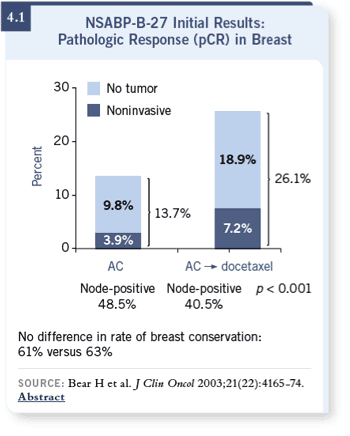
 Track 6 Track 6
 DR LOVE: Can you review
the results of the NSABPB-
27 study? DR LOVE: Can you review
the results of the NSABPB-
27 study? |
 DR BUDD: In NSABPB-
27, there was essentially a
doubling of the pathologic
complete response (pCR)
rate by adding docetaxel to
doxorubicin/cyclophosphamide
preoperatively (Bear
2003; [4.1]). However, there
was no advantage in terms of
the primary endpoint, which
was disease-free survival. DR BUDD: In NSABPB-
27, there was essentially a
doubling of the pathologic
complete response (pCR)
rate by adding docetaxel to
doxorubicin/cyclophosphamide
preoperatively (Bear
2003; [4.1]). However, there
was no advantage in terms of
the primary endpoint, which
was disease-free survival.
If you look at relapse-free
survival, which is any sort
of recurrence but excludes second breast cancers and other second primary malignancies, there is a
modest advantage for adding the docetaxel to doxorubicin/cyclophosphamide,
particularly preoperatively (Bear 2004). If you’re going to use docetaxel in the
adjuvant setting, I believe it ought to be TAC.
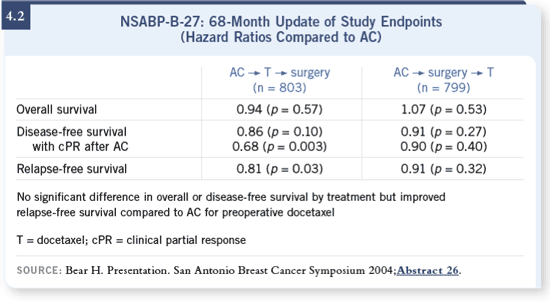
 Track 7 Track 7
 DR LOVE: In our patterns of care study, we looked at adjuvant hormonal
therapy in postmenopausal women. We saw a high utilization of the
aromatase inhibitors up front (4.3) — specifically anastrozole (4.4). What
are your thoughts on that? DR LOVE: In our patterns of care study, we looked at adjuvant hormonal
therapy in postmenopausal women. We saw a high utilization of the
aromatase inhibitors up front (4.3) — specifically anastrozole (4.4). What
are your thoughts on that? |
 DR BUDD: We’ve seen that the aromatase inhibitors are better than other
hormonal agents in every stage of the disease — as a second-line treatment for
metastatic disease and as first-line treatment for metastatic disease. It was not
much of a leap to believe that they’d be better in the adjuvant setting, and the
toxicities, in general, are less. DR BUDD: We’ve seen that the aromatase inhibitors are better than other
hormonal agents in every stage of the disease — as a second-line treatment for
metastatic disease and as first-line treatment for metastatic disease. It was not
much of a leap to believe that they’d be better in the adjuvant setting, and the
toxicities, in general, are less.
Patients are very concerned about bone density, as are their physicians. The
bottom line — in terms of the proportion of patients complaining about side
effects or quitting treatment because of side effects — is there is an advantage
for the aromatase inhibitors over tamoxifen.
 DR LOVE: Right now, which aromatase inhibitor do you utilize up front? DR LOVE: Right now, which aromatase inhibitor do you utilize up front?
 DR BUDD: I tend to use anastrozole up front, because I tend to follow the
clinical trial data (Howell 2005b). The BIG FEMTA trial, looking at letrozole,
has been presented but has not yet been published (Thürlimann 2005a, 2005b;
[4.5]). So I believe there’s a rationale to use letrozole as well. DR BUDD: I tend to use anastrozole up front, because I tend to follow the
clinical trial data (Howell 2005b). The BIG FEMTA trial, looking at letrozole,
has been presented but has not yet been published (Thürlimann 2005a, 2005b;
[4.5]). So I believe there’s a rationale to use letrozole as well.
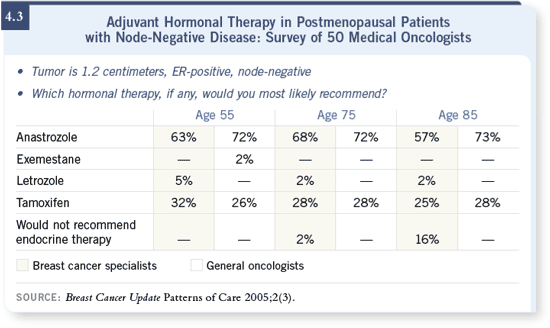
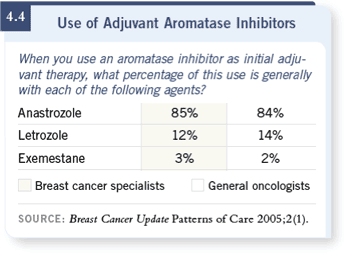  DR LOVE: The other thing
that was seen in the BIG
FEMTA trial that was
interesting was an increase
in deaths from myocardial
infarction. What are your
thoughts about that? DR LOVE: The other thing
that was seen in the BIG
FEMTA trial that was
interesting was an increase
in deaths from myocardial
infarction. What are your
thoughts about that?
 DR BUDD: I thought that
was an interesting finding,
and there are possibly adverse
effects on blood lipids. DR BUDD: I thought that
was an interesting finding,
and there are possibly adverse
effects on blood lipids.
It may be, too, that tamoxifen
has some beneficial effect in
terms of myocardial infarction, which has been noticed in some other studies.
This is a bit paradoxical when you compare this to trials with hormone
replacement therapy, in which there actually was an increase in cardiac events.
I believe we’ll just have to follow this further, to see whether tamoxifen, in
fact, might have some beneficial effects in terms of cardiac events.
 Track 11 Track 11
 DR LOVE: In our patterns of care study, we saw a lot of heterogeneity
in how physicians approach the postmenopausal patient with metastatic
disease, particularly the woman who had relapsed on adjuvant tamoxifen.
A fair number of physicians are using fulvestrant, while some are using
aromatase inhibitors (4.6). How do you approach that decision? DR LOVE: In our patterns of care study, we saw a lot of heterogeneity
in how physicians approach the postmenopausal patient with metastatic
disease, particularly the woman who had relapsed on adjuvant tamoxifen.
A fair number of physicians are using fulvestrant, while some are using
aromatase inhibitors (4.6). How do you approach that decision? |
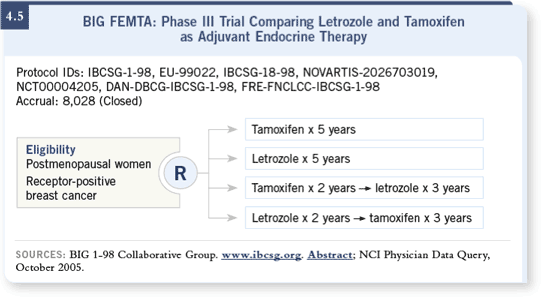
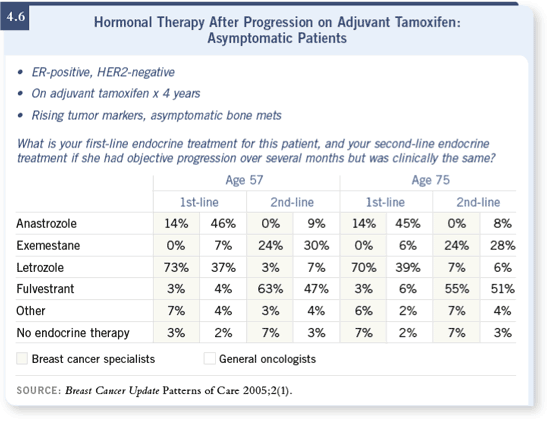
 DR BUDD: I tend to use an aromatase inhibitor first and then use fulvestrant.
One could build a rationale for using an alternative sequence, but I believe the
data for aromatase inhibitors are really quite strong. DR BUDD: I tend to use an aromatase inhibitor first and then use fulvestrant.
One could build a rationale for using an alternative sequence, but I believe the
data for aromatase inhibitors are really quite strong.
 DR LOVE: If you’re trying to decide between fulvestrant and an aromatase
inhibitor in a postmenopausal woman who’s relapsed on adjuvant tamoxifen,
what’s the advantage of the aromatase inhibitor from your point of view? DR LOVE: If you’re trying to decide between fulvestrant and an aromatase
inhibitor in a postmenopausal woman who’s relapsed on adjuvant tamoxifen,
what’s the advantage of the aromatase inhibitor from your point of view?
 DR BUDD: I believe ease of administration and the magnitude of the information.
We have trials with each one of these agents that indicate, in one way
or another, that the aromatase inhibitors are an optimal treatment. Granted,
anastrozole and fulvestrant appear to be equivalent in that situation (Robertson
2003; Howell 2005a; [4.7]). So fulvestrant is also a reasonable choice. DR BUDD: I believe ease of administration and the magnitude of the information.
We have trials with each one of these agents that indicate, in one way
or another, that the aromatase inhibitors are an optimal treatment. Granted,
anastrozole and fulvestrant appear to be equivalent in that situation (Robertson
2003; Howell 2005a; [4.7]). So fulvestrant is also a reasonable choice.
I believe most patients would still rather take a pill than have an intramuscular
injection, but not all. Many of these patients are coming back to the clinic on
a monthly basis for a bisphosphonate, so some of the practical advantages of a
pill may not pertain for all patients.
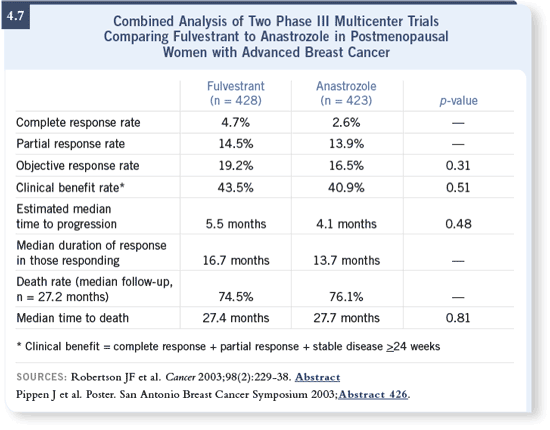
 DR LOVE: What’s been your experience with fulvestrant in terms of tolerability
and efficacy? DR LOVE: What’s been your experience with fulvestrant in terms of tolerability
and efficacy?
 DR BUDD: I found it to be quite tolerable. I’ve had some patients complain
about injections, but relatively few. I’ve tended to use it as second-line or even
third-line therapy, particularly when it first became available. The results
have been what I would expect for an active hormonal agent in that situation.
There have been some patients who have had prolonged responses, but
there are some patients who are hormone refractory and do not respond to it. I
believe it’s clearly an active agent, and it’s been tolerable to most patients. DR BUDD: I found it to be quite tolerable. I’ve had some patients complain
about injections, but relatively few. I’ve tended to use it as second-line or even
third-line therapy, particularly when it first became available. The results
have been what I would expect for an active hormonal agent in that situation.
There have been some patients who have had prolonged responses, but
there are some patients who are hormone refractory and do not respond to it. I
believe it’s clearly an active agent, and it’s been tolerable to most patients.
 Track 12 Track 12
 DR LOVE: Do you think there’s a future for fulvestrant being integrated
earlier into neoadjuvant or adjuvant therapy? DR LOVE: Do you think there’s a future for fulvestrant being integrated
earlier into neoadjuvant or adjuvant therapy? |
 DR BUDD: I believe there is a possibility. In the Southwest Oncology
Group, we are doing a trial in the metastatic setting (SWOG-S0226) with
anastrozole versus the combination of anastrozole and fulvestrant (4.8). If the
combination were better, then there would be a rationale to introduce it into
the adjuvant setting. DR BUDD: I believe there is a possibility. In the Southwest Oncology
Group, we are doing a trial in the metastatic setting (SWOG-S0226) with
anastrozole versus the combination of anastrozole and fulvestrant (4.8). If the
combination were better, then there would be a rationale to introduce it into
the adjuvant setting.
I believe the one lesson we’ve learned from the aromatase inhibitors is that
not all hormonal treatments are the same. Before the aromatase inhibitors, the
thought was, “The hormonal agents are all pretty similar in terms of efficacy.
We’ll just use them in terms of increasing toxicity, so we’ll use the least toxic
agent first.”
With the aromatase inhibitors, we’ve seen it is actually possible to have a
better hormonal agent. I believe that’s encouraged us to look at novel combinations
and, perhaps, the addition of other biologic agents. I believe there’s
been a change in viewpoint that’s come about with the aromatase inhibitors.
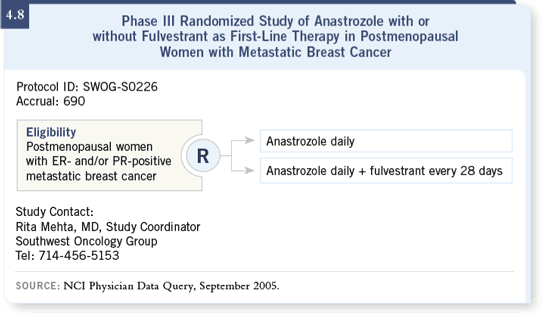
Select publications
|

